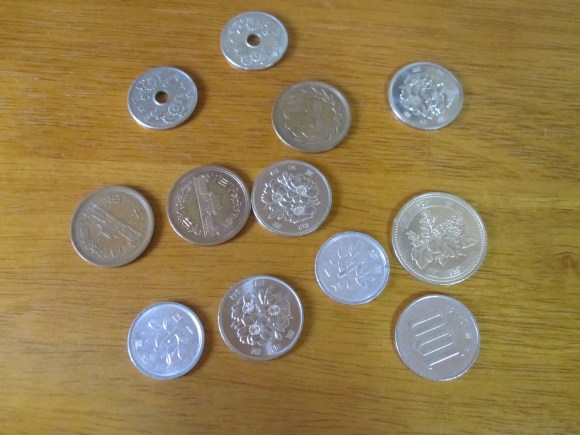
Dry ice is some pretty handy stuff. Aside from keeping shipments of groceries and other perishables nice and cold, it’s perfect for producing billowing smoke, which is always nice to have if you’re throwing a high school dance.
Dry ice doesn’t just have the power to compel teens to shake their bodies, though, but coins and spoons too, as shown in these awesome videos.
YouTube user Leak Fische shows that all you need to produce the natural (and dance) phenomenon is a chunk of dry ice and some pocket change. Just grab a coin, jab it into the ice, and let it go!
Instantly, the coin starts vibrating, beating out a fast-tempo rhythm as it bounces off the hard ice. But while dry ice is a mainstay of Halloween parties and haunted houses, there’s no sorcery at play here, just science.
▼ Science: It’s like magic for smart people!
Below -78.5 degrees Celsius (-109.3 degrees Fahrenheit), dry ice is solid. Once its surface temperature rises above that, it sublimates, or converts to a gas without going through a liquid state, which is why it’s called “dry” ice.
Obviously, a block of dry ice is colder than a coin you have lying around your home (and if it’s not, for God’s sakes turn the heater on). Metal acts as a thermal conductor, and stabbing the coin into dry ice causes it to rapidly sublimate, which is why you can see bits of vapor coming off it as the coin oscillates back and forth.
The specific type of metal used seems to affect how quickly the process happens. Both the 100-yen coin Leak Fische uses first and the five-yen piece shown after get up to pretty good speeds, with the hole in the middle of the latter giving it its own unique pitch. The featherweight one-yen coin, though, doesn’t do quite as well, as it stops after about two seconds.
▼ Pressing the coin into the slit does cause some screeching, but you could get the same result by stabbing a human being with it.
Of course, coins aren’t the only things made out of metal, and you can make similar things happen with a variety of objects. For example, the Raku Raku Kagaku Jikken (Easy Science Experiments) channel shows that if you lay a spoon on a block of dry ice and close your eyes, you’d swear your alarm clock was going off.
▼ Where’s the snooze button?
Proof positive that not only is science fun, it’s noisy too.
Source: Labaq
Top image: YouTube
Insert images: RocketNews24, YouTube, Wikipedia/Cmglee, YouTube (2)

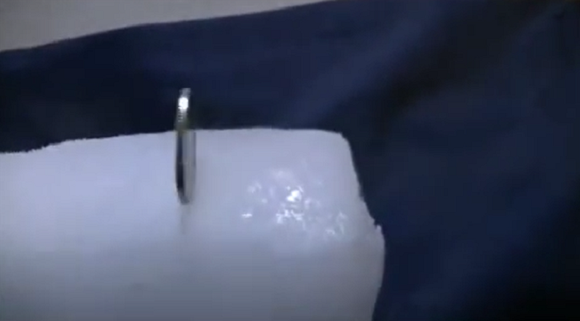
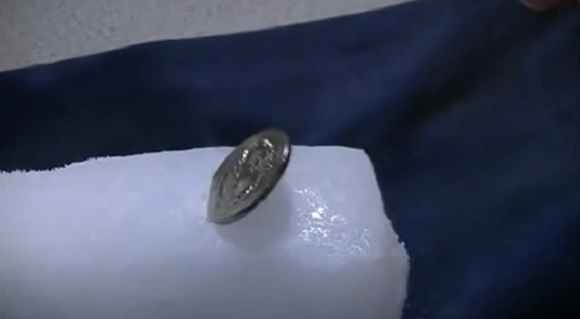
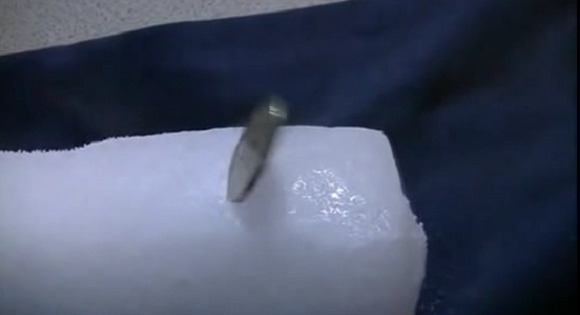

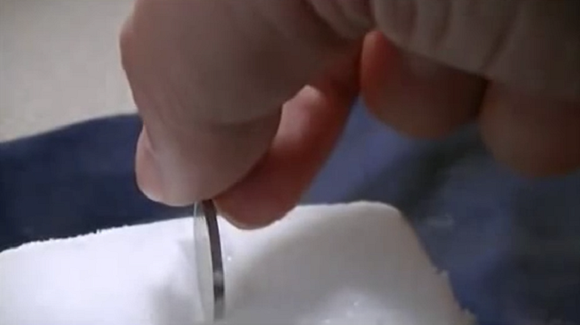
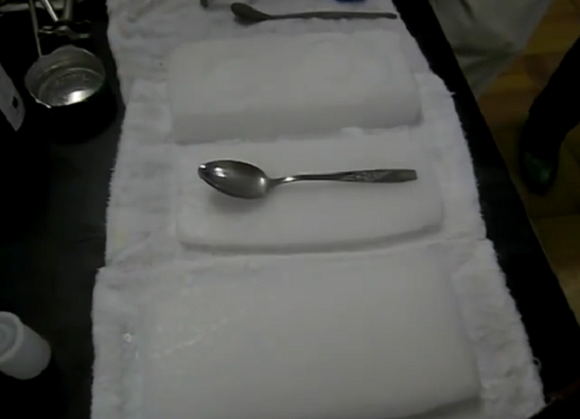
 Does Japan’s five-yen coin need a foreigner-friendly redesign?
Does Japan’s five-yen coin need a foreigner-friendly redesign? This amazing suit of samurai armor is made of five-yen coins, and you can make your own too【Pics】
This amazing suit of samurai armor is made of five-yen coins, and you can make your own too【Pics】 Misprinted 1-yen coin sells for US$27,500 at auction
Misprinted 1-yen coin sells for US$27,500 at auction Awe-inspiring coin sculpture erected during boring holiday
Awe-inspiring coin sculpture erected during boring holiday Japan’s 500-yen coin has two hidden messages, and here’re where to find them 【Photos】
Japan’s 500-yen coin has two hidden messages, and here’re where to find them 【Photos】 Is the new Shinkansen Train Desk ticket worth it?
Is the new Shinkansen Train Desk ticket worth it? Our reporter takes her 71-year-old mother to a visual kei concert for the first time
Our reporter takes her 71-year-old mother to a visual kei concert for the first time Disney princesses get official manga makeovers for Manga Princess Cafe opening in Tokyo
Disney princesses get official manga makeovers for Manga Princess Cafe opening in Tokyo Randomly running into a great sushi lunch like this is one of the best things about eating in Tokyo
Randomly running into a great sushi lunch like this is one of the best things about eating in Tokyo What happens to Cup Noodle Mystery Meat when you cook it in a rice cooker?
What happens to Cup Noodle Mystery Meat when you cook it in a rice cooker? Foreign English teachers in Japan pick their favorite Japanese-language phrases【Survey】
Foreign English teachers in Japan pick their favorite Japanese-language phrases【Survey】 New definition of “Japanese whiskey” goes into effect to prevent fakes from fooling overseas buyers
New definition of “Japanese whiskey” goes into effect to prevent fakes from fooling overseas buyers Beautiful new Final Fantasy T-shirt collection on the way from Uniqlo【Photos】
Beautiful new Final Fantasy T-shirt collection on the way from Uniqlo【Photos】 Citizen celebrates the 140th anniversary of Ueno Station with cool train-themed watch designs
Citizen celebrates the 140th anniversary of Ueno Station with cool train-themed watch designs Traditional silverwork pairs with the power of the moon in this stunning Silver Crystal pendant
Traditional silverwork pairs with the power of the moon in this stunning Silver Crystal pendant We try out “Chan Ramen”, an underground type of ramen popular in the ramen community
We try out “Chan Ramen”, an underground type of ramen popular in the ramen community New Studio Ghibli bedding sets are cool in all senses of the word
New Studio Ghibli bedding sets are cool in all senses of the word Our Japanese reporter visits Costco in the U.S., finds super American and very Japanese things
Our Japanese reporter visits Costco in the U.S., finds super American and very Japanese things New Pokémon cakes let you eat your way through Pikachu and all the Eevee evolutions
New Pokémon cakes let you eat your way through Pikachu and all the Eevee evolutions There’s a park inside Japan where you can also see Japan inside the park
There’s a park inside Japan where you can also see Japan inside the park Japanese convenience store packs a whole bento into an onigiri rice ball
Japanese convenience store packs a whole bento into an onigiri rice ball Hanton rice — a delicious regional food even most Japanese people don’t know about, but more should
Hanton rice — a delicious regional food even most Japanese people don’t know about, but more should Final Fantasy, Kingdom Hearts, and Dragon Quest pet product line announced by Square Enix
Final Fantasy, Kingdom Hearts, and Dragon Quest pet product line announced by Square Enix Studio Ghibli releases Kiki’s Delivery Service chocolate cake pouches in Japan
Studio Ghibli releases Kiki’s Delivery Service chocolate cake pouches in Japan Japan’s bone-breaking and record-breaking roller coaster is permanently shutting down
Japan’s bone-breaking and record-breaking roller coaster is permanently shutting down Foreign passenger shoves conductor on one of the last full runs for Japan’s Thunderbird train
Foreign passenger shoves conductor on one of the last full runs for Japan’s Thunderbird train Kyoto bans tourists from geisha alleys in Gion, with fines for those who don’t follow rules
Kyoto bans tourists from geisha alleys in Gion, with fines for those who don’t follow rules Studio Ghibli unveils Mother’s Day gift set that captures the love in My Neighbour Totoro
Studio Ghibli unveils Mother’s Day gift set that captures the love in My Neighbour Totoro Domino’s Japan now sells…pizza ears?
Domino’s Japan now sells…pizza ears? Toyota built a life-sized Miraidon Pokémon and are letting people test drive it this weekend
Toyota built a life-sized Miraidon Pokémon and are letting people test drive it this weekend New Japanese KitKat flavour stars Sanrio characters, including Hello Kitty
New Japanese KitKat flavour stars Sanrio characters, including Hello Kitty Sales of Japan’s most convenient train ticket/shopping payment cards suspended indefinitely
Sales of Japan’s most convenient train ticket/shopping payment cards suspended indefinitely Sold-out Studio Ghibli desktop humidifiers are back so Totoro can help you through the dry season
Sold-out Studio Ghibli desktop humidifiers are back so Totoro can help you through the dry season Japanese government to make first change to romanization spelling rules since the 1950s
Japanese government to make first change to romanization spelling rules since the 1950s Ghibli founders Toshio Suzuki and Hayao Miyazaki contribute to Japanese whisky Totoro label design
Ghibli founders Toshio Suzuki and Hayao Miyazaki contribute to Japanese whisky Totoro label design Doraemon found buried at sea as scene from 1993 anime becomes real life【Photos】
Doraemon found buried at sea as scene from 1993 anime becomes real life【Photos】 Tokyo’s most famous Starbucks is closed
Tokyo’s most famous Starbucks is closed One Piece characters’ nationalities revealed, but fans have mixed opinions
One Piece characters’ nationalities revealed, but fans have mixed opinions We asked a Uniqlo employee what four things we should buy and their suggestions didn’t disappoint
We asked a Uniqlo employee what four things we should buy and their suggestions didn’t disappoint Princesses, fruits, and blacksmiths: Study reveals the 30 most unusual family names in Japan
Princesses, fruits, and blacksmiths: Study reveals the 30 most unusual family names in Japan Studio Ghibli’s new desktop Howl’s Moving Castle will take your stationery on an adventure
Studio Ghibli’s new desktop Howl’s Moving Castle will take your stationery on an adventure This ice cream spoon uses your body heat to get the perfect scoop, costs more than most desserts
This ice cream spoon uses your body heat to get the perfect scoop, costs more than most desserts Japan’s favorite beer, Asahi Super Dry, to get new low-alcohol spinoff
Japan’s favorite beer, Asahi Super Dry, to get new low-alcohol spinoff Japan issuing beautiful new coins to celebrate Emperor Naruhito’s enthronement
Japan issuing beautiful new coins to celebrate Emperor Naruhito’s enthronement We try a method for making ice cream that doesn’t require a freezer【SoraKitchen】
We try a method for making ice cream that doesn’t require a freezer【SoraKitchen】 Silver 1,000 yen coin to be issued for Shinkansen’s 50th anniversary
Silver 1,000 yen coin to be issued for Shinkansen’s 50th anniversary Japan’s Slime ice cream will Heal you since it’s a Dragon Quest tie-up with Baskin-Robbins Japan
Japan’s Slime ice cream will Heal you since it’s a Dragon Quest tie-up with Baskin-Robbins Japan In Japan, one yen coins don’t get picked up by strangers in public – they multiply instead
In Japan, one yen coins don’t get picked up by strangers in public – they multiply instead Hello Kitty keeping as busy as ever — this time she collaborates with…money itself!
Hello Kitty keeping as busy as ever — this time she collaborates with…money itself! Hello Kitty Data Leak: If you have a SantrioTown account, you might want to change your password
Hello Kitty Data Leak: If you have a SantrioTown account, you might want to change your password The mesmerizing art of stacking Japanese coins 【Photos】
The mesmerizing art of stacking Japanese coins 【Photos】 How much treasure can you find on a Japanese beach with a metal detector?
How much treasure can you find on a Japanese beach with a metal detector? Cute cat bank collects coins, makes fiscal responsibility adorable 【Videos】
Cute cat bank collects coins, makes fiscal responsibility adorable 【Videos】 We taste test Baby Star Ramen on Ice Cream: 10 points apiece for crunchiness, creaminess
We taste test Baby Star Ramen on Ice Cream: 10 points apiece for crunchiness, creaminess Häagen-Dazs Japan recommends ice cream with tomato and avocado, so we trust them and try it
Häagen-Dazs Japan recommends ice cream with tomato and avocado, so we trust them and try it Ramen ice cream on sale at 7-Eleven in Japan to help us multitask our comfort food consumption
Ramen ice cream on sale at 7-Eleven in Japan to help us multitask our comfort food consumption Adorable talking Pokémon Eevee coin bank is here to take your money, make you happy about it【Vid】
Adorable talking Pokémon Eevee coin bank is here to take your money, make you happy about it【Vid】
Leave a Reply